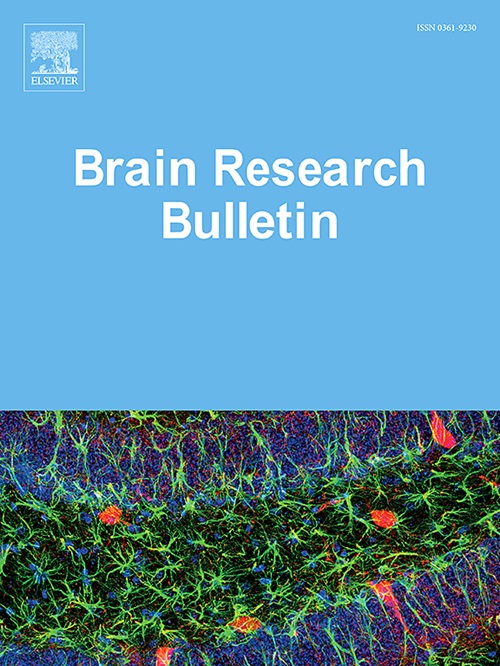减轻吗啡依赖和戒断:文拉法辛和钙通道阻滞剂在脑线粒体损伤和氧化应激中的作用
IF 3.5
3区 医学
Q2 NEUROSCIENCES
引用次数: 0
摘要
吗啡依赖和戒断症状的原因是脑内氧化应激和细胞线粒体功能障碍。文拉法辛是一种5 -羟色胺-去甲肾上腺素再摄取抑制剂(SNRI),可以减轻氧化应激,而钙通道阻滞剂(尼莫地平/地尔硫平)可以预防ca2 +介导的线粒体功能障碍。本研究评估了文拉法辛和钙通道阻滞剂同时给药对吗啡依赖和戒断综合征的影响,以及线粒体损伤和氧化应激的作用。方法采用热板法考察文拉法辛、尼莫地平和地尔硫卓的镇痛作用,确定后续实验的最佳用药剂量。为了诱导吗啡依赖和戒断综合征,雄性NMRI小鼠连续3天给予50 mg/kg S.C.吗啡,第4天给予5 mg/kg S.C.吗啡。末次给药后2 小时,腹腔注射纳洛酮(5 mg/kg), 0.5 小时评价跳跃和站立体征。文拉法辛(20 mg/kg)单用或与尼莫地平(10 mg/kg)和地尔硫卓(40 mg/kg)联用,在吗啡(50 mg/kg)前半小时给药,连续三天。在光镜下对脑切片进行染色和检查。采用重复离心法分离脑线粒体,研究线粒体氧化应激。测定脑线粒体脱氢酶活性(MTT)、膜电位(MMP)、活性氧(ROS)生成速率、谷胱甘肽(GSH)、丙二醛(MDA)含量。数据以均数±标准差表示,p值小于0.05认为有统计学意义。结果与对照组(吗啡加纳洛酮溶剂)相比,反复注射吗啡后给予纳洛酮加重了戒断症状(P <; 0.01)。与吗啡+纳洛酮组相比,吗啡前给予文拉法辛-尼莫地平和文拉法辛-地尔硫卓可减轻这些症状(P <; 0.01)。与对照组相比,先注射吗啡后再注射纳洛酮降低了MTT和GSH,增加了MDA、MMP和ROS (P <; 0.01),而在吗啡前半小时注射文拉法辛-尼莫地平和文拉法辛-地尔硫卓与吗啡+纳洛酮组相比,降低了这些变化(P <; 0.05)。结论文拉法辛与钙通道阻滞剂联用可减轻吗啡戒断症状,防止其病理损害。这一事件的机制可能是防止吗啡引起的线粒体损伤和氧化应激。本文章由计算机程序翻译,如有差异,请以英文原文为准。
Mitigating morphine dependence and withdrawal: The role of venlafaxine and calcium channel blockers in mitochondrial damage and oxidative stress in the brain
Background
The reasons for morphine dependence and withdrawal symptoms are oxidative stress and dysfunction of cell mitochondria in the brain. Venlafaxine, a serotonin-norepinephrine reuptake inhibitor (SNRI), mitigates oxidative stress, while calcium channel blockers (nimodipine/diltiazem) prevent Ca²⁺-mediated mitochondrial dysfunction. In the present study, the effects of simultaneous administration of venlafaxine and calcium channel blockers on dependence and withdrawal syndrome of morphine and the role of mitochondrial damage and oxidative stress were assessed.
Methods
In this experimental study, the analgesic effect of venlafaxine, nimodipine, and diltiazem was investigated using the hot plate test to determine the optimal doses of drugs to use in subsequent experiments. To induce morphine dependence and withdrawal syndrome, male NMRI mice were treated with 50 mg/kg S.C. morphine for three consecutive days and 5 mg/kg S.C. morphine on the fourth day. 2 hours after the last dose of morphine, naloxone (5 mg/kg) was injected intraperitoneally, and the signs of jumping and standing were evaluated for 0.5 hours. Venlafaxine (20 mg/kg) alone or in combination with nimodipine (10 mg/kg) and diltiazem (40 mg/kg) was administered half an hour before morphine 50 mg/kg for three days. Brain slides were stained and examined under a light microscope. Brain mitochondria were isolated using a repeated centrifugation method to investigate mitochondrial oxidative stress. The dehydrogenase activity (MTT), membrane potential (MMP), ROS production rate, glutathione (GSH), and malondialdehyde (MDA) contents of the brain mitochondria were measured. The data were expressed as mean±standard deviation, and a p-value less than 0.05 was considered statistically significant.
Results
The administration of naloxone following repeated morphine injection increased withdrawal symptoms compared to the control group (morphine followed by solvent of naloxone) (P < 0.01). Administration of venlafaxine-nimodipine and venlafaxine-diltiazem before morphine reduced these symptoms compared to the morphine + naloxone group (P < 0.01). The injection of morphine followed by naloxone decreased MTT and GSH and increased MDA, MMP, and ROS compared to the control group (P < 0.01), and the injection of venlafaxine-nimodipine and venlafaxine-diltiazem half an hour before morphine reduced these alterations when compared to morphine + naloxone group (P < 0.05).
Conclusion
Coadministration of venlafaxine with calcium channel blockers could reduce morphine withdrawal symptoms and prevent its pathological damage. The suggested mechanism of this event is preventing mitochondrial damage and oxidative stress induced by morphine.
求助全文
通过发布文献求助,成功后即可免费获取论文全文。
去求助
来源期刊

Brain Research Bulletin
医学-神经科学
CiteScore
6.90
自引率
2.60%
发文量
253
审稿时长
67 days
期刊介绍:
The Brain Research Bulletin (BRB) aims to publish novel work that advances our knowledge of molecular and cellular mechanisms that underlie neural network properties associated with behavior, cognition and other brain functions during neurodevelopment and in the adult. Although clinical research is out of the Journal''s scope, the BRB also aims to publish translation research that provides insight into biological mechanisms and processes associated with neurodegeneration mechanisms, neurological diseases and neuropsychiatric disorders. The Journal is especially interested in research using novel methodologies, such as optogenetics, multielectrode array recordings and life imaging in wild-type and genetically-modified animal models, with the goal to advance our understanding of how neurons, glia and networks function in vivo.
 求助内容:
求助内容: 应助结果提醒方式:
应助结果提醒方式:


